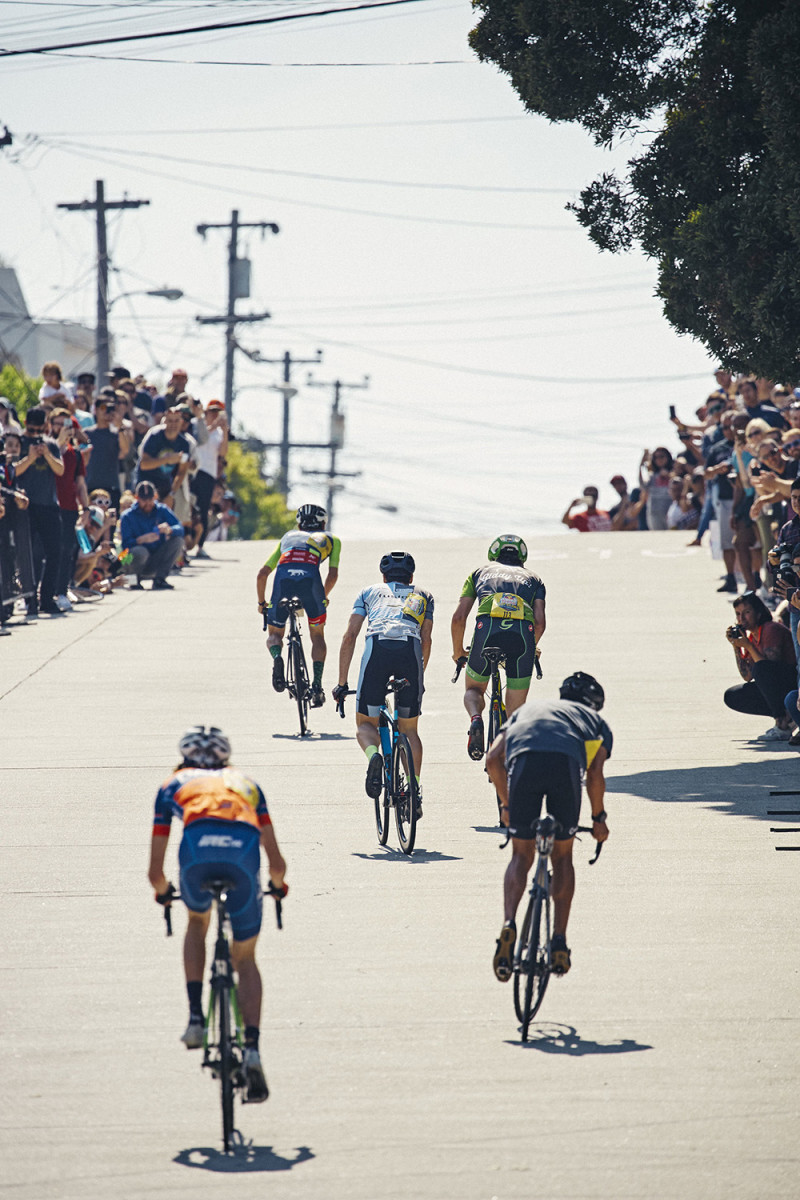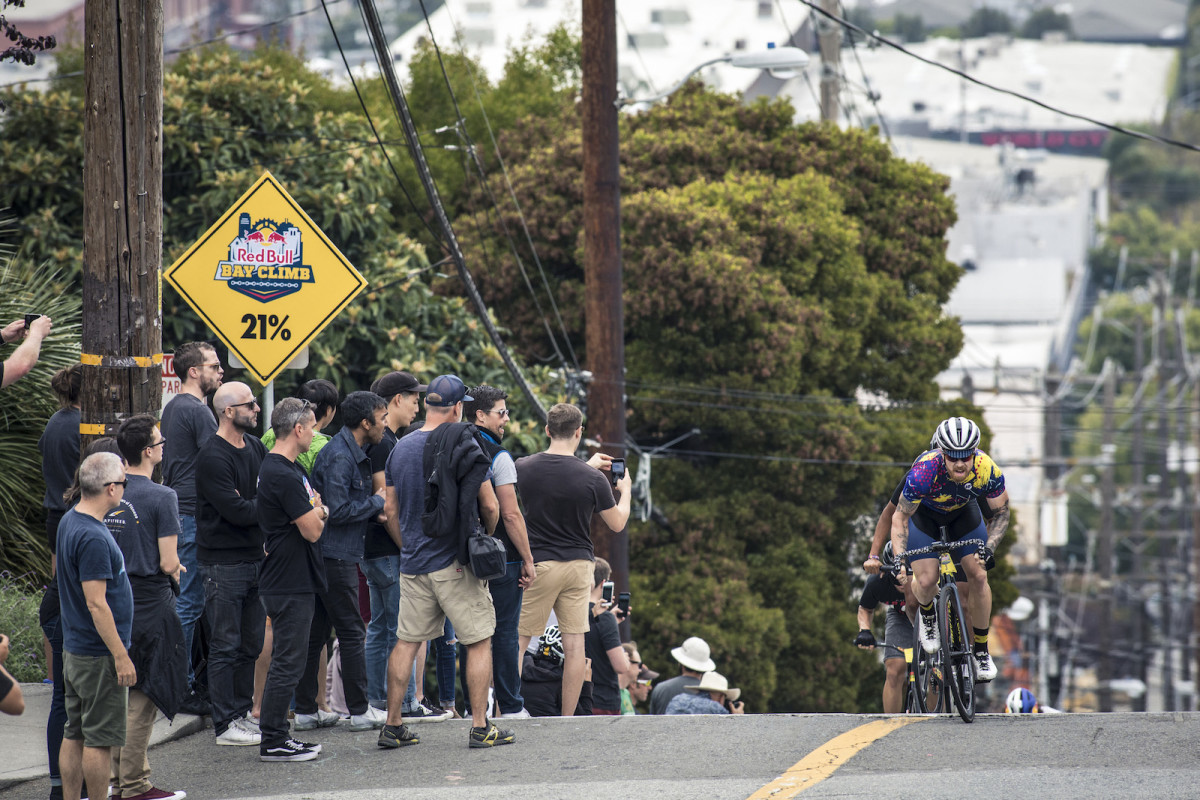What Is it Like to Race Up Some of the Toughest Hills In America On a Bike?

There is no good reason for riding a bike three-blocks straight up. But on Saturday, Sep. 16, more than 180 riders did just that in a sprint race on De Haro Street up Potrero Hill in San Francisco.
Starting at 18th Street, the Red Bull Bay Climb course ran due south three blocks until De Haro crested the hill at Southern Heights Avenue. Each intersection was more or less flat, but the slopes between them were not. The first climb was a 400-foot stretch at an 11% gradient, the second spanned the same distance but at a 21% gradient, and the third was a 550-foot run out at about 13%.

“That second hill is like hitting a wall,” said Red Bull fixed gear cyclist Nico Deportago-Cabrera. A bike messenger in Chicago, one of the flattest cities in one of the flattest states, the closest Deportago-Cabrera, 33, usually comes to hills is riding into the Windy City’s gales. In comparison, Potrero Hill is steep enough that as riders lined up at the start, the final section of the route was completely obscured from view by the second rise. That final third was the nasty surprise everyone knew they had coming. When Deportago-Cabrera was eliminated in the semifinals, he could at least console himself with not having the race the course again.
“You’d think that the steepest one would be the most challenging,” said Hanna Muegge, 28, a pro road cyclist with Visit Dallas DNA, “but for some reason the adrenaline is still relatively high and it’s steady at 21% that you can’t go any faster. If you pick a pace you’re going the same pace [as everyone else]. The gaps don’t really expand too much.
“Then you crest over that and you have a short intersection to recover, and then that’s where the endurance portion kicks in.”
13 Unexpected Athletes on SI’s Fittest 50
Muegge, who won the women’s open category at the Bay Climb, said. Lungs burning and legs aching, riders struggling to find anything extra to give. “It’s a race of attrition, who has saved the most and can have a final kick.”
Why would over a hundred riders, most of them not pros, and most unlikely to sneak away with the $750 prize for first place, put their bodies through this? And why would a multi-billion dollar company invest in a popup race that bemused local residents who came out to watch?
For its part, Red Bull never seems to have a good reason. The company’s main product, a syrupy $2 energy drink, is conspicuously absent from its website, which instead features stories on adventure sports and entertainment. Red Bull owns two Formula 1 teams, Red Bull Racing and Scuderia Toro Rosso, and runs an air racing championship where aerobatic pilots fly around a course made up of huge inflatable cones. On Sep. 30, a thousand competitors will run 400 meters up a ski jump in Park City, Utah, as part of the Red Bull 400 series. Either this somehow helps sell six billion cans per year and justifies a brand valuation of $8.7 billion, or selling soft drinks is really an excuse for everything else.
Three years ago, Red Bull ran this bike race the other way around, downhill. That day, James Grady, a fixie rider who runs a local criterium race called the Mission Crit, hit the hay bales at the end of that course, tumbled over them, and broke three ribs hitting pavement on the other side. Grady, 34, was back this year at the scene of his accident, working the crowd as the start line announcer. “You don’t need to go fast,” he said, “you just need to go faster than other people.”
Not content with the challenge of simply riding the hills, some racers insisted on making the challenge even harder. They eschewed feather-light carbon fiber road bikes in favor of mountain bike frames complete with heavy shock absorbers. One competitor showed up wearing a tiger costume, another rode with his dog in a backpack. Jacob Kessler, 29, from Stockton, Calif., raced the open category on a street-style BMX bike, with a single gear, no brakes, small, 20-inch wheels—most road bikes and many newer mountain bikes have 29-inch wheels—and metal pegs sticking out of the sides of the axles for grinding rails. Smaller wheels actually meant Kessler could accelerate quicker off the line, but if he lost momentum he’d be done for. And everyone lost momentum on the second hill.
Part of the motivation for the Bay Climb was to create a hill climb race for fixed-gear riders. “I love climbing on fixies. There’s something wrong with me. It’s fun,” said Kym “NonStop” Perfetto, a pro fixie racer from Brooklyn who also gained fame in 2014 when she finished fifth with her teammate Alli Forsythe in season 25 of CBS’s The Amazing Race.
On a fixie, you pick the specific gear ratios when you assemble your bike pre-race. There is no shifting up, your top speed is limited by how fast your legs will go around. And there is no shifting down into an easier gear on the hills. “I like not being able to back down,” Perfetto, 33, said.
“There’s not really strategy,” said Austin Horse, another Red Bull fixie racer. “The only strategy is really if you can trick your body into doing something that it thinks it can’t.”

Perfetto’s mind battled with her body in the women’s fixie final, her internal monologue running in circles as she willed her bike forwards and upwards. I don’t know if I got it, she feared. Then: I got it! I don’t know if I got it. I got it!
On the second hill, another rider, Julie Cushen, powered past her and Perfetto felt control on the race slipping. She took two seconds to breathe when the climb flattened out at the intersection with 20th Street before the final climb to Southern Heights Avenue. She tucked in behind Cushen, stayed close as the new leader tried to stretch the gap, and then ground her way back to the front as Cushen began to fade. As her nickname implies, Perfetto doesn’t give up. She got it.
